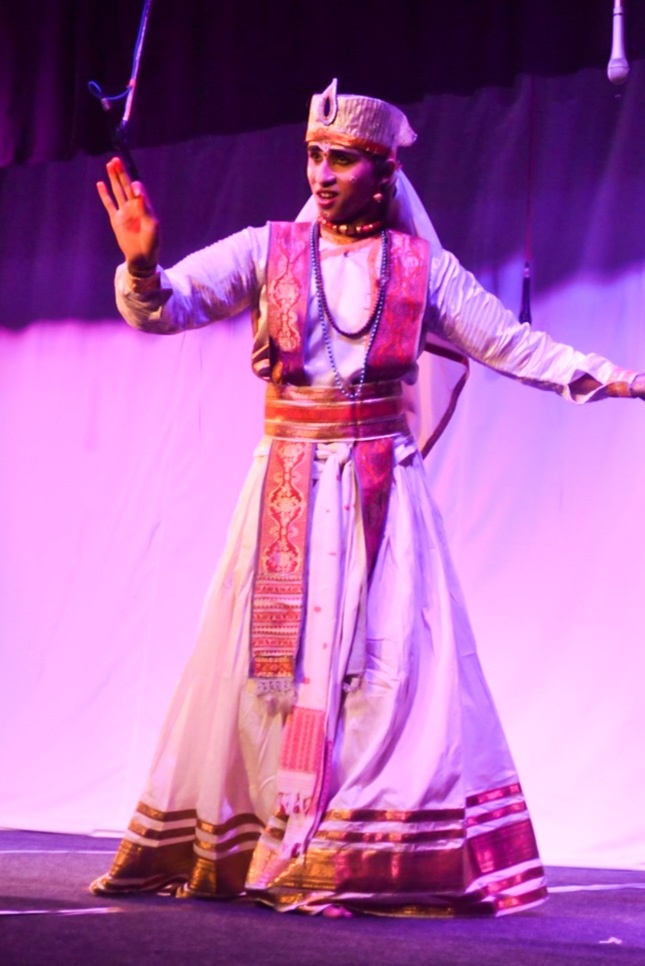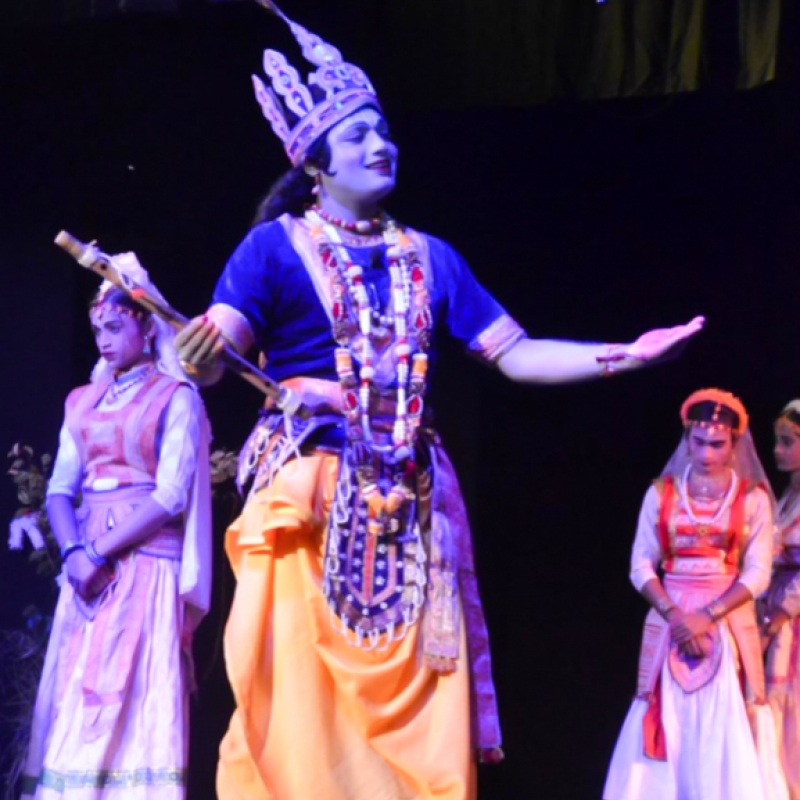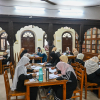Sattras are monastic institutions of the neo-Vaishnavite tradition that are unique because of their practise of a form of Bhakti that employs dance, music and theatre for the dissemination of religious ideas. Although much has been written about the history of sattras and the art forms that flourished there, the ‘processes’ and rituals of teaching and learning, which are significant components of the knowledge system and identity of the bhakat (monk), have not received much scholarly attention. The bhakat is a religious being, an embodiment of a rich oral tradition and a performing artist.
Learning to be a bhakat involves changes in bodily dispositions, speech and consciousness, and personification of art forms through apprenticeship. The gurus are the master craftsmen who mould the apprentices through their teachings.
The apprenticeship at the sattra is a pedagogical form where the master and disciple are not in an economic relationship but bound by a devotion and a sense of responsibility as bhakats, to preserve their own identities and art forms. The bhakat community itself constitutes the living curriculum for the apprentice. While rituals are learnt and acquired through peripheral participation, the art forms follow a rigorous formal learning process.
A Novice’s Journey
Learning to be a bhakat involves multiple stages. The young novices mostly belong to upper caste, low-income households and come from different parts of Assam. Earlier, when families were larger, one son would be offered to the sattra for his religious alleviation. There was also a belief that if the son was ailing, the sattra environment could assuage the suffering and cure him.
The number of boys who join sattras to become bhakats has reduced significantly. Though, nowadays, there are economic interests in offering sons to the sattras. The boys acquire traditional knowledge, receive training and become economically valuable as performing artists, which potentially enables them to gain a livelihood.
The journey of a novice begins with his separation from home. Bhakats from the sattra go to receive the novice at his natal home, perform ritual chanting and offer a fresh set of garments (dhoti-sador) before bringing him to the monasteries. Families bid a tearful farewell to their son.
‘It felt like the house had suddenly gone empty and we lost one of us,’ recalls an old lady whose grandson had left home to become a bhakat.
Once the novice is brought to the sattra, he is given a few days to settle into the new environment and conferred a new name. He receives his first instruction on the norms around bodily cleanliness and taught how to drape the dhoti-sador, which becomes his attire. The novice is presented before the sattradhikar (head of the monastery) for blessings and taken to the kirtanghar (prayer hall) for prayer, after which he begins his lessons in guru-bhotima (chants) and gayan (singing) under a guru at the sattra.
The boha (household unit) is the novice’s new home where he weaves new webs of intimacy. The novice is called and treated as bhakator-lora, which means honorary son of the bhakat. At the boha, the hierarchy is based on age. The eldest bhakator-lora is the next in line in terms of authority. In the absence of the burhabhakat (head of the household and senior-most member), he takes on all the responsibilities. As they grow up, the bhakator-loras eventually succeed the burhabhakat and gain more decision-making power. The novices of the same age group share strong ties and look up to the elder apprentices as mentors. (Fig. 1)

To become a bhakat, the apprentice must observe, internalise and enact a series of bodily restrictions, like celibacy and personal hygiene. ‘Purity’ is a critical part of the devotion and draws on the idea that a clean body means a clear conscience. It is not so much about the physical aspect of dirt but a matter of disorder and displacement of status.[1] Most bhakats understand very early on that ritual purity is a non-negotiable condition.
A typical day at the sattra begins with the bhakat rising at the crack of dawn to take the first ritual bath and put on a fresh set of dhoti-sador, before the sound of the doba (drums) at the kirtanghar announces the morning prayer. Bhakats are allowed to present themselves at the kirtanghar only as pure bodies and hence must cleanse themselves before the three main prayers of the day, held in the morning, noon and evening. When the bhakat steps out of the sattra for work or any other engagement, he must, to regain their pure status, take a ritual bath and wear a new set of clean robes.
The rituals that novices observe are critical in shaping their identities. Rituals are an information storage system. They are condensed forms of knowledge that are transmitted to successive generations of practitioners. The bhakats keep hair unshorn, neatly pulled back into a bun. This is similar to the practice in Sikhism where hair is kept in the ‘natural’ state without interfering with the ‘will’ of God. During performances, the hair is often pulled up into a turban but if the bhakat is portraying a female character in dance or theatre, they use their long hair for effect. The novice thus adopts the common codes through which he is integrated into a community of practice.
Gurus and the Oral Tradition
The art forms at the sattra, which also exercise considerable influence on the bodies and minds of the apprentices, are taught through a rigorous regime under gurus. The guru is revered as the living embodiment of the art forms and it is through his instruction, utterance, demonstration and direction that the apprentices gain access to the resources. The bhakats’ devotion to their art is aligned with their devotion to the Lord and their livelihood, and must be understood within a moral spiritual universe.
The process of learning is rigorous and gets progressively more complex. In Sattriya dance specifically, the malleability of the body, poise, and sense of rhythm is tested first through training in mati akhara (ground exercises, which is the main grammatical component of the tradition, and includes flexibility exercises to prepare a dancer’s body for advanced choreographic numbers. (Fig. 2) Only those who are able to learn, follow and mould their bodies into the desired form for the dance through mati akhara are encouraged to pursue Sattriya more seriously; the rest are asked to keep music, theatre or scriptures as their focus. These are, however, not mutually exclusive. For instance, those who learn bayan (percussion) also need to develop a sense of movement and rhythm so that the body and the instrument are one.

Apprentices mostly learn art forms in a small mixed-ability group under one guru. The senior apprentice is a co-teacher who takes the lead with compositions. While the senior apprentice is subjected to continuous evaluation during the lesson, the youngest disciple is expected to listen and sing along. The process is learner-centric, where the apprentice is allowed to move ahead once he has gained satisfactory command over a lesson and has displayed it to the guru. The faster they progress, the sooner they get into advanced compositions. There is no concept of ‘failure’ as learning is a constant movement. The apprentice who becomes proficient in a number of compositions in gayan or bayan is expected to perform at the kirtanghar (prayer hall) on designated days as part of their learning and practice. Their development is judged on the basis of their ability to perform with flair.
Honorary titles are conferred upon those who have mastered the art forms. For instance, the title bor-bayan is an honour reserved for the most experienced guru and performer in percussion at the sattra. Master practitioners across sattras are identified by these titles, which are suffixed to their names.
The Bhakat’s Identity and their Art Forms Today
The notion of monkhood has changed with time and under the influence of media, market and forces of ‘modernity’.[2] The professional field has presented new challenges and also raised new demands that the bhakats negotiate in order to maintain their identities as artists and sustain themselves. The art forms that emerged at the sattra have been secularised, systematised and appropriated by the State as a part of intangible cultural heritage and have become accessible to the general masses.[3] Although creative innovations have always been a part of the evolution of the arts, sattras present themselves as the preservers of the ‘authentic’ and ‘pure’ forms of the art.[4]
The bhakats note that there is a bifurcation between the ritual space and the professional stage. With technological interventions and mechanical reproduction, there has been an emphasis on the visual aspects like lighting, costumes and choreography. While at the sattra, the emphasis of teaching is on the devotion and collective effervescence through sound, movement and rhythm, entering the performance stage before an audience entails a different kind of preparation, where details like costumes, footwork and synchrony are given more attention. (Fig. 3) The gurus at the sattra today try to balance the professional demands as well as preserve the religiously embedded nature of the art while teaching.

The close association of the art forms to the aspect of livelihood changes the way the apprentices imagine their learning. There are many art-based scholarships sponsored by the state and competitions that they actively participate in to build their identities as artists. Apprentices who have had the opportunity to perform and participate in these competitions and cultural programmes to showcase their ‘skill’ for remuneration are caught in a paradox. On one hand, they are restrained by the monastic philosophy of asceticism and on the other, they are to navigate a world where their identity as professional artists can bring opportunities and prosperity that they avowed to renounce. The identity of the bhakat is constantly shaped by the process of negotiating boundaries between different worlds like the performance stage, the professional field and the ritual space. Many young bhakats have bridged the two but there are also those who choose to exit the sattra and monastic life to seize financially viable opportunities in the outside world.
The number of bhakats at sattras has dwindled rapidly, with fewer families offering their sons to monkhood. Bhakats face the challenge of keeping their tradition relevant and are compelled to find new ways to adapt to changing contexts. They have responded to changing times by providing value education in schools and earning a livelihood through their training in the arts.
Notes
[1] Douglas, Implicit Meanings.
[2] Sharma and Singh, 'Changing Notions of ‘Ideal’ Monkhood.'
[3] In November 2000, Sattriya was recognised by the Sangeet Natak Akademi as one of the eight forms of Indian classical dance.
[4] Mahanta, 'Understanding the Paradigms of Sattriya Dance.'
Bibliography
Douglas, Mary. Implicit Meanings: Essays in Anthropology. London: Routledge, 1975.
Mahanta, Anwesha. 'Understanding the Paradigms of Sattriya Dance and Dancer in the Changing Space.' In Dance Matters Too: Markets, Memories, Identities, edited by P. Chakravorty and N. Gupta, 264–83. Oxon: Taylor and Francis, 2018.
Sharma, Pranalee and Asha Singh. 'Changing Notions of "Ideal" Monkhood: Case study from a Satra of Majuli.' Space and Culture 4, no. 2 (2016): 29–38.
Tamuli, Krishna. 'Desi and Margi Interpretation in Sattriya Nrittya.' International Journal of Advanced Research 2, no. 2 (2014): 1–11.













